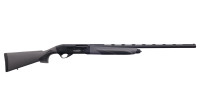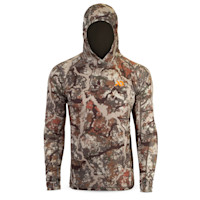
Welcome to the Duck Lore Breakdown, an article series that corresponds to each episode of Duck Lore, airing every Tuesday on YouTube for the next six weeks. In these articles, we’re going to dive a little deeper into what's going on during the show. We’ll go through the weather and hunt conditions, the target species and their environment, as well as episode-specific gear that was used and the technology of some of that gear.
Target Species The target species is blue-winged teal, one of the smallest and tastiest ducks. Blue-wings eat a variety of plants, sedges, seeds, and invertebrates, and their ideal habitat is shallow flooded vegetation. Think 6 to 12 inches of water, with vegetation so thick you can hardly see them. This explains why the coastal plains of Texas are a major stopping point for blue wings; there’s lots of shallow flooded grass and flooded rice.
The Status of the Migration Blue-winged teal are what we’d call calendar migrators. They start their journey south in September every year, likely based on the shortening days well ahead of the rest of North America’s duck species. This early migratory pattern prevents the vast majority of hunting seasons, especially in the South, from having a chance at blue-wings.
So much of the U.S. has “teal-only” seasons in September that allow hunters to take advantage of this early season. During this season, you’ll experience somewhat randomized migrations; you don’t know what day the teal will be on the move, but there’s no denying they will be. You just need to be in the marsh on the days they do.
Hunt 1
Weather Conditions East wind @ 0-5mph. Sunny and clear. High temp: 91 Low temp: 71
Sean’s Hunt Notes Today was opening day. There was easily 30 groups of hunters scattered around the marsh, and it was so calm you could hear anxious voices and boats clanging. It was clear that night, and the Dakotas had two days of Northwest winds prior.
When the sun came up, there was a classic blue wing flight at first light; singles, pairs, three-packs buzzing around the marsh in opening-day mayhem. But later in the morning, around 8:30 a.m., what appeared to be migratory flocks began their move.
They flew around the marsh relatively high, and in big numbers, anywhere from 10 to 30 birds per flock on average. They didn’t seem to have a locked-in destination, giving them the look of "new birds." And when they saw our spinning wing decoys, they’d come down fast. These teal wasted no time decoying, and often would flutter over the spinners on their first pass. We ended up with 10 blue wings, all beautiful birds that plucked easily.
Hunt 2
Weather Conditions Wind: Light and Variable. Sunny, with storm clouds in the distance to the south. Tropical disturbance gets upgraded to Tropical Storm Nicholas. High temp: 91 Low temp: 75
Sean’s Hunt Notes Today, we went back to the spot we hunted for opening day, and it was a mistake. To our west, some hunters were having one heck of a day. The water there was shallower, and filled with flooded vegetation. The birds were keyed in on that premium habitat, and it showed. The hunters there were on the X, and came back with full straps and smiles. We got skunked.
Hunt 3
Weather Conditions Wind: SE Wind @ 10-20 mph Cloudy, raining, with strong gusts of wind at 40mph as the outer bands of Tropical Storm Nicholas make landfall. High temp: 85 Low temp: 60
Sean’s Hunt Notes This morning’s hunt was in a private rice field with my good friend Kevin Diehl at Run N Gun Adventures. We had to use his Can-Am to get to our spot, as the rain from the arriving tropical storm had the levee roads pretty slippery–it would have been pretty risky to take a truck through that.
We also used homemade palmetto holders to make a blind with the abundant palmettos you find all around here; it was the easiest setup I’ve ever had. The hunting was a little slow to start, but then we got a shot of rain with some wind. Right when the wind subsided and the rain lightened up, the birds started moving heavy and fast. We didn’t shoot a limit, but the flocks that did it were right and tight, landing in the decoys.
The Gear Breakdown
Excel 1860 F4 Boat w/ Mud Buddy 4400 Mud Motor from Xtreme Outdoors The most important piece of gear was the boat. This specific boat allowed us to run in this very shallow water, especially when the tide was out, and go about 4 miles into the marsh. Many times, we were running on full plane in about 8 inches of water with two camera guys, Jean-Paul, and myself.
First Lite - Warm When Wet For this hunt, it was really hot, and dumping body heat while still having protection from the sun was important. However, it was also humid, and you were going to get wet at some point; from the rain, chasing downed birds, or even the dew on the sedges. My go-to piece for an early season hunt like this quickly became the Wick Hoody, an ultralight wool piece.
While most people only think of wool as insulating, First Lite’s Ultralight 150 Aerowool is very breathable and moisture-wicking, dries quickly, and merino wool actually creates a cooling effect when it evaporates your sweat. Not that it applied on this hunt, but the benefits of wearing merino wool get even better (hardly doing it justice) when it gets wet. Go do some googling yourself; when water gets absorbed into the wool fibers, there’s a breakdown of the hydrogen bond in the water molecules, which in turn creates heat. Yes, merino wool generates heat when it gets wet.
As far as the Wick Crew shirt vs. the Wick Hoody; the hood is a nice bonus for the sun and mosquitos, even though the damn mosquitos always find a way through. The last day, in the down-pouring rain, I stuck with the 150 Wick Hoody under my shell, because it gave me just enough insulation in the colder rain temperatures.
For my under-wader pant, I wore the First Lite Guide Lite Pant. With 90-degree day temperatures and 95% humidity, it’s hard to stay cool in waders, even breathable Simms. But these are the most breathable and lightweight pants I own, they were perfect for staying cool under my waders, and they’re also comfortable.
Can-Am Defender Our rice-field hunt showed why a Can-Am is always nice to have around. It was way too muddy for a pickup truck, so we would have had a mile walk-in and out with cameras in a down-pouring rain if it wasn’t for Kevin having his Can-Am. On top of that, you get the inside of the Can-Am muddy, not your pickup.
FHF Chest Rig There were two main reasons to use the Chest Rig on this hunt, and boy was it a necessary piece of gear. When we were scouting the marsh I needed to have easy access to onX to see my path through the endless maze of channels and my binos for looking at birds. Having them both on my chest was easy and secure.
Vortex Razor 10x42 These binoculars are great for scouting birds, and they go with me everywhere. The lowlight performance is the real important part for that twilight differentiation.
onX Hunt onX is the most bang for the buck piece of “gear” I use. I use it for hours a day during hunting season. On this hunt, the tracking feature was very important; the satellite images aren’t perfectly reflective of each little opening and cut in the sedges, so you better be able to know each turn you make. The tracking feature gives me that.
Avery Push Pole w/ Marsh Foot Attachment. When you come off plane to look at birds, and you stop over a clam bed, you’re going to have to push pole your way out.
Weatherby Element w/ Stock Extended Choke (included with shotgun) This shotgun was great to me on this hunt. It went bang and it cycled, like a shotgun should.
Federal Premium Black Cloud Ammunition On this hunt, I shot the 3” #3 shot 1 1/8 ounce load, and it did its job. Maybe should have shot the #4s.
Dakota Decoy Gadwall Hens and Mallard Hens I separated out the drakes and left them at home, to have the “brown” early season look in my decoy spread.
Dakota Decoy Blue-winged teal Filled out the spread with these for at least some smaller body form.
Lucky Duck Lucky Junior II This is a spinning wing decoy that I can hook to a remote. Smaller body/wing size that fits the bill for teal season.
Lucky Duck Agitator HD and Lucky Duck Quiver Duck Butt HD The agitator splashes and throws water in the air, and the quiver butt makes ripples throughout the spread, again, great for calm conditions.
Simms G3 Waders These kept me dry when setting up decoys, retrieving ducks, and sitting through hurricane rain.
Lastly, more Off! Deepwoods bug spray than you should legally be allowed to own.






